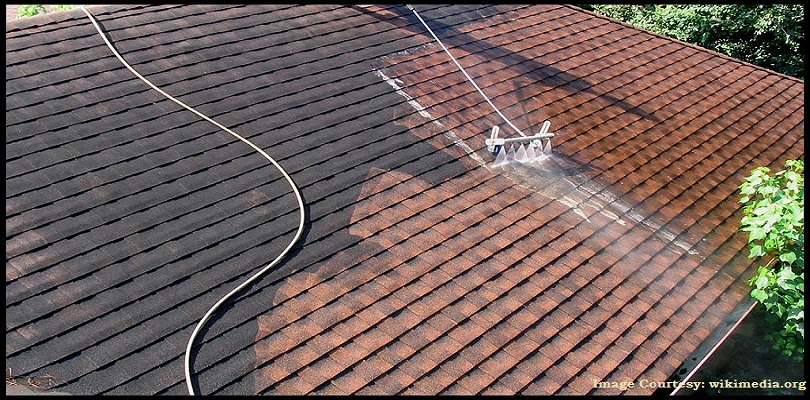Not known Facts About Roof Cleaning
Table of ContentsExcitement About Roof CleaningLittle Known Facts About Roof Cleaning.Fascination About Roof Cleaning6 Easy Facts About Roof Cleaning Described
Associated Short article No, asphalt shingles should not be power cleaned. A power washing machine or pressure washer is too solid to utilize on asphalt roof shingles and will certainly loosen up the sticky holding them to your roofing, causing them to fall off. It's ideal to work with a regional roofing system cleaner to clean those tiles safely and without damaging them.Soft cleaning entails a naturally degradable cleaning solution being splashed on the roofing system and delicately rinsed away after it liquifies built-up residue on your tiles. The very best season to clean your roof is late spring right into early summer season. You wish to have the ability to depend on dry weather and clear skies to be able to do the task correctly, which these periods tend to have most perfectly.
Before you start cleansing your roofing system, you'll desire to deal with some general upkeep tasks. If there is any type of standing water on your roof covering, you'll want to remove it. You'll additionally require to remove any type of bigger particles from the roofing system prior to you start cleansing. If landscape design or garden beds are near the building, take actions to protect both the soil and the plants, as the dirt can be infected, and the plants can be damaged (or also eliminated) by bleach or chlorine solutions.
Unknown Facts About Roof Cleaning

You have a handful of options for cleaning your level roof covering, each of which has advantages and disadvantages. The very first option is using a stress washer, which can easily get rid of algae and moss and properly tidy your flat roof covering. Among the benefits of this technique is that it doesn't utilize any chemicals, indicating that you do not have to stress about the soil and plants around your structure being contaminated or harmed.

This method requires much more considerable rinsing than the chlorine solution, and ensuring your solution isn't too focused is very important. You'll intend to use severe care when making use of salt hydroxide because using a service that is also focused can cause damage to your roofing product. The site here majority of residences in the united state have asphalt shingle roofing systems, a lot of different roof-cleaning items get on the market targeted at customers.
Simply like when you're cleaning up a flat roof covering, the first point you'll wish to care for when cleaning an asphalt tile roof covering is some basic maintenance tasks. Tidy out your rain gutters to ensure they can bring water away from your structure properly. You'll likewise want to take actions to read more protect any kind of plants that are near your home or building.
How Roof Cleaning can Save You Time, Stress, and Money.
There are likewise a number of roof covering cleaning options offered that you can buy, as well as all-natural choices such as vinegar. As soon as you have actually picked your cleaner, it's time to obtain your yard sprayer and mix your remedy. As you begin cleaning the roofing, you'll want to start high on the roof covering and start applying an also layer of your remedy.
If there are any type of locations of your roofing that have a lot of algae growth, you may intend to include a 2nd layer of the cleaning chemical after regarding five mins. Roof Cleaning. There are various sorts of algae and moss that can grow on roofing systems, several of which are heartier than others
For brand-new roofings or roofs that you know remain in great shape, you may be able to escape a roof cleansing as soon as every two years. One of the advantages of having an annual roof covering cleansing is that it allows you to end up being conscious of any kind of concerns with your roof click for source beforehand.
Roof Cleaning for Beginners

Typically, it costs between $0.20 and $0.70 to clean up a roof covering per square foot. This means that a 2,000-square-foot roof will set you back between $400 and $1,400 to tidy. Roof Cleaning. There are a variety of factors it deserves cleaning your roofing system once a year, including: Assisting to stop your roof covering from damages due to moss or algae growth Permitting you (or a roof covering professional) to notice any type of other prospective concerns that can come to be more expensive problems down the roadway Expanding the life of your roof covering Protecting your shingle warranty Boosting your home's visual charm Saving you money in the future by helping to avoid pricey fixings Where you live is mosting likely to have a large effect on the most effective season to cleanse a roof covering
Of program, you'll want to see to it it's cozy sufficient to do so. Beyond that, you actually desire to seek a gloomy instead of sunny day to ensure that the bleach remedy doesn't vaporize also fast. Furthermore, you don't intend to cleanse your roofing on a windy day or a day when there is precipitation.
If your roof is covered in dark algae, this can indicate that your roofing system absorbs a lot more warmth and, in turn, increases the temperature in your attic room. The result is that your A/C needs to run more frequently and endure even more wear and tear. Furthermore, some roofing materials are created these days to show warmth from the sun and therefore lower the temperature of your roof covering.